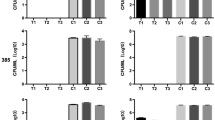Abstract
Mucormycosis is an aggressive and high-mortality opportunistic fungal infection, especially in immunocompromised patients. Conventional antifungals or surgery showed a limited effect on this disease. The antimicrobial photodynamic therapy (aPDT) has been proven to be a promising therapeutic choice against multiple pathogenic fungi. We evaluated the effect of aPDT by using methylene blue (MB) combined with a light emitting diode (LED) on the viability of Rhizopus oryzae, as well as the antifungal susceptibility after aPDT treatment in vitro. A total of six strains were included in this study; MB (8, 16, and 32 μg/ml) was chosen for the photosensitizer, and a light source of LED (635 ± 10 nm, 12 J/cm2) device was used to active it. aPDT with MB (32 μg/ml) and LED was highly effective in cell growth inhibition and exhibited colony-forming unit reductions of up to 4.3log10. The minimal inhibitory concentration ranges of itraconazole, posaconazole, and amphotericin B decreased from > 32 μg/ml to 4–8 μg/ml, 8–16 μg/ml to 0.5–2 μg/ml, and 2–4 μg/ml to 0.25–0.5 μg/ml, respectively, after pre-treatment with MB (8 μg/ml) and LED. In conclusion, aPDT with MB and LED was a promising therapeutic option against R. oryzae infections alone or combined with antifungal agents. However, further investigation is needed to determine the potential for clinic therapy and to elucidate the underlying mechanism.

Similar content being viewed by others
References
Bitar D, Van Cauteren D, Lanternier F, Dannaoui E, Che D, Dromer F, Desenclos JC, Lortholary O. Increasing incidence of zygomycosis (mucormycosis), France, 1997–2006. Emerg Infect Dis. 2009;15(9):1395–401.
Roden MM, Zaoutis TE, Buchanan WL, Knudsen TA, Sarkisova TA, Schaufele RL, Sein M, Sein T, Chiou CC, Chu JH, Kontoyiannis DP, Walsh TJ. Epidemiology and outcome of zygomycosis: a review of 929 reported cases. Clin Infect Dis. 2005;41(5):634–53.
Marty FM, Cosimi LA, Baden LR. Breakthrough zygomycosis after voriconazole treatment in recipients of hematopoietic stem-cell transplants. N Engl J Med. 2004;350(9):950–2.
Lewis RE, Kontoyiannis DP. Epidemiology and treatment of mucormycosis. Future Microbiol. 2013;8(9):1163–75.
Husain S, Alexander BD, Munoz P, Avery RK, Houston S, Pruett T, Jacobs R, Dominguez EA, Tollemar JG, Baumgarten K, Yu CM, Wagener MM, Linden P, Kusne S, Singh N. Opportunistic mycelial fungal infections in organ transplant recipients: emerging importance of non-Aspergillus mycelial fungi. Clin Infect Dis. 2003;37(2):221–9.
Qiao J, Li R, Ding Y, Fang H. Photodynamic therapy in the treatment of superficial mycoses: an evidence-based evaluation. Mycopathologia. 2010;170(5):339–43.
Calzavara-Pinton P, Rossi MT, Sala R, Venturini M. Photodynamic antifungal chemotherapy. Photochem Photobiol. 2012;88(3):512–22.
Lu Q, Sun Y, Tian D, Xiang S, Gao L. Effects of Photodynamic Therapy on the Growth and Antifungal Susceptibility of Scedosporium and Lomentospora spp. Mycopathologia. 2017;182(11–12):1037–43.
Gao L, Jiang S, Sun Y, Deng M, Wu Q, Li M, Zeng T. Evaluation of the Effects of Photodynamic Therapy Alone and Combined with Standard Antifungal Therapy on Planktonic Cells and Biofilms of Fusarium spp. and Exophiala spp. Front Microbiol. 2016; 7: 617.
Carmello JC, Alves F, Ribeiro AP, Basso FG, de Souza Costa CA, Tedesco AC, Primo FL, Mima EG, Pavarina AC. In vivo photodynamic inactivation of Candida albicans using chloro-aluminum phthalocyanine. Oral Dis. 2016;22(5):415–22.
Hu Y, Huang X, Lu S, Hamblin MR, Mylonakis E, Zhang J, Xi L. Photodynamic therapy combined with terbinafine against chromoblastomycosis and the effect of PDT on Fonsecaea monophora in vitro. Mycopathologia. 2015;179(1–2):103–9.
Nunes Mario DA, Denardi LB, Brayer Pereira DI, Santurio JM, Alves SH. In vitro photodynamic inactivation of Sporothrix schenckii complex species. Med Mycol. 2014;52(7):770–3.
Morton CO, Chau M, Stack C. In vitro combination therapy using low dose clotrimazole and photodynamic therapy leads to enhanced killing of the dermatophyte Trichophyton rubrum. BMC Microbiol. 2014;14:261.
Gilaberte Y, Aspiroz C, Martes MP, Alcalde V, Espinel-Ingroff A, Rezusta A. Treatment of refractory fingernail onychomycosis caused by nondermatophyte molds with methylaminolevulinate photodynamic therapy. J Am Acad Dermatol. 2011;65(3):669–71.
Lyon JP, Pedroso e Silva Azevedo Cde M, Moreira LM, de Lima CJ, de Resende MA. Photodynamic antifungal therapy against chromoblastomycosis. Mycopathologia. 2011;172(4):293–7.
Souza LW, Souza SV, Botelho AC. Distal and lateral toenail onychomycosis caused by Trichophyton rubrum: treatment with photodynamic therapy based on methylene blue dye. An Bras Dermatol. 2014;89(1):184–6.
Clinical and Laboratory Standards Institute. Reference method for broth dilution antifungal susceptibility testing of filamentous fungi; approved standard-2nd ed. CLSI document M38-A2. CLSI, Wayne, PA. 2008.
Ribes JA, Vanover-Sams CL, Baker DJ. Zygomycetes in human disease. Clin Microbiol Rev. 2000;13(2):236–301.
Ribeiro AP, Andrade MC, da Silva Jde F, Jorge JH, Primo FL, Tedesco AC, Pavarina AC. Photodynamic inactivation of planktonic cultures and biofilms of Candida albicans mediated by aluminum–chloride–phthalocyanine entrapped in nanoemulsions. Photochem Photobiol. 2013;89(1):111–9.
Carrera ET, Dias HB, Corbi SCT, Marcantonio RAC, Bernardi ACA, Bagnato VS, Hamblin MR, Rastelli ANS. The application of antimicrobial photodynamic therapy (aPDT) in dentistry: a critical review. Laser Phys. 2016;26(12).
Acknowledgements
This work was supported by National Natural Science Foundation of China (31400131 to Lujuan Gao and 81401677 to Yi Sun), and Hubei Province Health and Family Planning Scientific Research Project (WJ2018H178 to Yi Sun).
Author information
Authors and Affiliations
Corresponding authors
Ethics declarations
Conflict of interest
The authors report no conflicts of interest. The authors alone are responsible for the content and writing of the paper.
Additional information
Handling Editor: Cunwei Cao.
Publisher's Note
Springer Nature remains neutral with regard to jurisdictional claims in published maps and institutional affiliations.
Rights and permissions
About this article
Cite this article
Liu, Z., Tang, J., Sun, Y. et al. Effects of Photodynamic Inactivation on the Growth and Antifungal Susceptibility of Rhizopus oryzae. Mycopathologia 184, 315–319 (2019). https://doi.org/10.1007/s11046-019-00321-2
Received:
Accepted:
Published:
Issue Date:
DOI: https://doi.org/10.1007/s11046-019-00321-2




